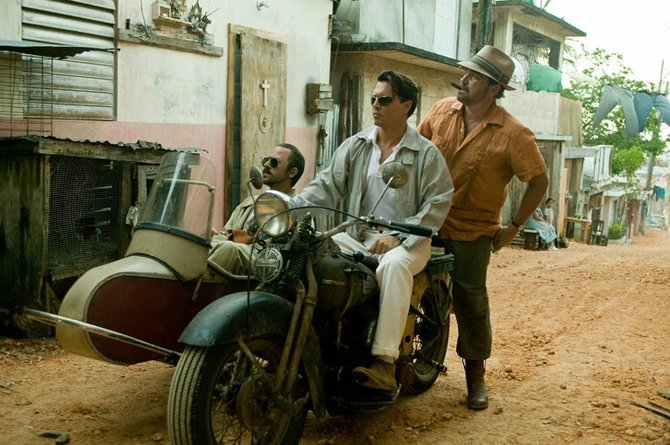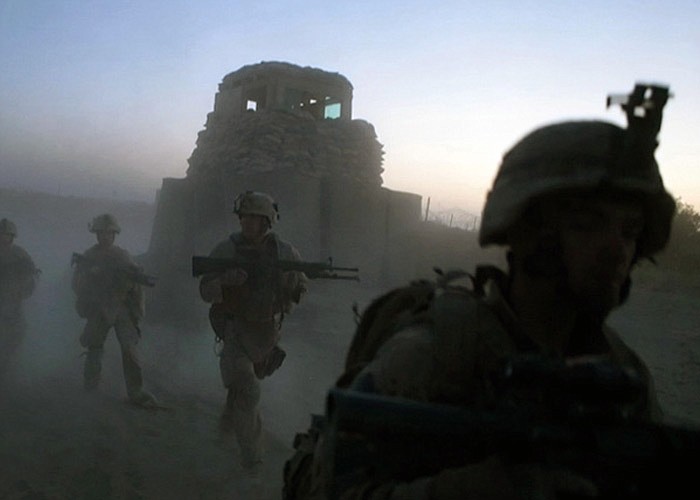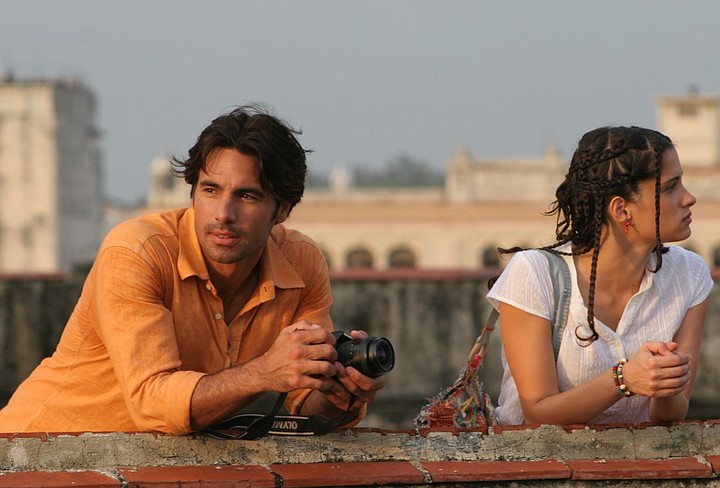 Facebook
Facebook
 X
X
 Instagram
Instagram
 TikTok
TikTok
 Youtube
Youtube

Johnny Depp delivers his second film-incarnation of a Hunter S. Thompson character: Paul Kemp, a freelance journalist who takes a job at a financially crippled newspaper in Puerto Rico. Paul is quickly tangled in a web of illegal real estate deals, dangerous romantic prospects, and all manner of alcohol-related hijinks. The script is unapologetically literary; everyone speaks from Thompson’s prose. The direction, much like Thompson’s writing, meanders more than it hits the mark.
Photographed in a dry, dingy beige, the film looks like it were being viewed through a discarded snakeskin. This is not altogether a fault; the anemic film stock suits the sultry drip of setting and the revolutionary climate of the time.
Johnny Depp — in a pair of brow-hugging sunglasses that turn his head into a smiling V — plays Paul Kemp, a freelance journalist who takes a job at a financially crippled newspaper in Puerto Rico. This is Depp’s second film incarnation of a Hunter S. Thompson character. And like all Thompson’s protagonists, Paul shares the wistful woes of the struggling writer. He hopes the spicy locale will jumpstart his stalled career as a novelist.
His initial reporting begins in the horoscopes, but soon Paul is tangled in a web of illegal real estate deals, dangerous romantic prospects, and all manner of alcohol-related hijinks. Thankfully, the drug-induced surrealism of Fear and Loathing is restricted to a single scene. Aaron Eckhart is appealing as the wealthy devil in a white suit, and Amber Heard is seductive and stunning as the love interest, though she still looks like something that fell out of Scarlett Johansson’s compact. Michael Rispoli turns in some credible work as veteran of the newspaper, but his role is ultimately reduced to that of Depp’s sidekick.
The script is unapologetically literary. Everyone speaks from Thompson’s prose: “This place is like someone you fucked, and you’re still under it.” The overreaching eloquence can be somewhat excused by the fact that most of the characters are writers, but writers don’t often speak as they write. The story indulges in its own sense of esoteric becoming. This liberty extends to Bruce Robinson’s direction as well. Much like Thompson’s writing, the film meanders aimlessly, achieving fleeting moments of majesty.
Danfung Dennis’s startling documentary follows U.S. Marine Sgt. Nathan Harris through his recovery after being shot in the hip while serving his third tour in Afghanistan. We are privy to the actual footage from the battlefield leading up to Harris’s injury. The camera is remarkably steady, given the roughness of the terrain and the jeopardy of the mission. Harris is an intriguing subject -- a soldier with deep conviction and unique demons. A disturbing kind of irony emerges as the “home” scenes become more unnerving than the battle sequences.

“I just want to kill people.” In this documentary by Danfung Dennis, this is the response of 18-year-old Nathan Harris when asked in a military interview why he wants to join the Marines. Perhaps more frightening than Harris’s comment is the response from the interviewer: “That’s the best answer I’ve ever heard.”
This conversation is recollected by Harris when he is 25, now a sergeant in the U.S. Marine Corps. For his third tour in Afghanistan, Harris is selected as a member of the elite Echo Company, who have been charged with taking the war deep into Taliban-controlled territory. They are, as the commanding officer says, “experts in the application of violence.” Harris is shot in the hip, leaving his prospect of returning to service questionable. His welcome-home sequence is effectively interspliced with quick cutaways to soldiers in the grips of despair, suicidal behavior, and physical maladies.
As we follow Harris’s recovery, the editing is used to take the viewer back to the deserts of Afghanistan, where we are privy to actual footage from the battlefield leading up to Harris’s injury. Even without the flashback technique, the battle footage would be compelling. The camera is remarkably steady, given the roughness of the terrain and the jeopardy of the mission. One wonders how the shaky-hand technique of contemporary directors ever came to be considered an aspect of realism in war.
Harris is an intriguing subject — he’s an “everyman” soldier with deep conviction and an individual with unique demons. He is small of stature, with a firm brow, ghostly complexion, and arresting eyes. Routine banalities, such as shopping in a Walmart, take on a kind of hyper reality as Harris stares transfixed by the release of Call of Duty 4. What could he be thinking? Even if the battle footage is presented in a gimmicky style that dramatizes the experience, the reality of the images free it from sentimentality.
The film speaks intelligently on the disconnect between a soldier on the front lines and the logistics of how a mission is planned. The person fighting is left to carry out his duty on faith alone (“We all believe in the cause”), likening military service to a kind of religious zeal. The film also explores the extent to which Afghani farmers are forced to sacrifice their livelihood for the sake of a foreign freedom they do not understand. The enemy remains unseen for the duration of the film, underscoring the authenticity of the danger.
A strong sense of irony emerges as the home scenes become tenser than the battle sequences — note a moment when Harris is trying to teach his clearly uncomfortable wife how to aim a handgun. Harris practically forces the weapon into her hand, his voice an innocent drawl but with an expectant tone. He is both endearing and aggressive. Even as his physical injuries heal, Harris’s mental instability deteriorates to the point of psychosis. His descent is captured in a way few modern documentaries attempt — not with a parade of talking-head interviews, but as a document of an important experience.
Eva is a dreamer in a world of assimilated perspectives. Her workday consists of sewing in a factory, but her ambition is to become a famous fashion designer. Enter Jorge, a well-to-do charmer whose world-weary aesthetic provides Eva with just the escape she needs. Unfortunately, the performances do not live up to the good looks. The acting is self-conscious, the movements too static, the dialogue too forced. The photography never rises above the tour-guide variety, but the colors create a vibrant palette.

Eva is a dreamer in a world of assimilated perspectives. Her fiancé is a passionless architect. Her family is stuck in a pedestrian rut of soap operas and pet adoration. Her workday consists of sewing in a factory that produces economical, unflattering wedding dresses. Her ambition to become a fashion designer of the highest artistic caliber paints Eva as a bit of a pariah amid the socialist climate of Havana, Cuba: “Beauty is not a priority here.”
Enter Jorge (played with convincing suavity by Juan Carlos García), a well-to-do charmer with a smile that could melt an iceberg. His world-weary aesthetic provides Eva with just the escape she needs, finding justification for her infidelity and reckless behavior in a swish of romantic abandon. Jorge, of course, proves too good to be true (though his deception is never all that sinister), and Eva is left all alone to discover her independence and realize her dreams.
Prakriti Maduro in the lead role provides a nice foil for her male counterparts. She darts through her scenes like a mouse but with conviction, using her frumpy eyes, pouty lips, and head full of Medusa braids. Unfortunately, the performances do not live up to the good looks. The acting is self-conscious, like a well-rehearsed high school play. The movements are too static, the dialogue too forced.
Havana is filmed in all its luscious splendor, but the photography never rises above the tour guide variety. Even so, the colors create a vibrant palette; they pop in a way few directors of urban locales are willing to permit. And while the story entraps itself in the romantic-comedy formula, there are some unfamiliar turns (at least in American cinema) that keep interest alive — most notably a pair of goblin-colored seniors who become business partners with Eva and a friendly haunting who comes to dispense legal advice.
Reviewed in the movie capsules: In Time and A Very Harold & Kumar 3-D Christmas.


Johnny Depp delivers his second film-incarnation of a Hunter S. Thompson character: Paul Kemp, a freelance journalist who takes a job at a financially crippled newspaper in Puerto Rico. Paul is quickly tangled in a web of illegal real estate deals, dangerous romantic prospects, and all manner of alcohol-related hijinks. The script is unapologetically literary; everyone speaks from Thompson’s prose. The direction, much like Thompson’s writing, meanders more than it hits the mark.
Photographed in a dry, dingy beige, the film looks like it were being viewed through a discarded snakeskin. This is not altogether a fault; the anemic film stock suits the sultry drip of setting and the revolutionary climate of the time.
Johnny Depp — in a pair of brow-hugging sunglasses that turn his head into a smiling V — plays Paul Kemp, a freelance journalist who takes a job at a financially crippled newspaper in Puerto Rico. This is Depp’s second film incarnation of a Hunter S. Thompson character. And like all Thompson’s protagonists, Paul shares the wistful woes of the struggling writer. He hopes the spicy locale will jumpstart his stalled career as a novelist.
His initial reporting begins in the horoscopes, but soon Paul is tangled in a web of illegal real estate deals, dangerous romantic prospects, and all manner of alcohol-related hijinks. Thankfully, the drug-induced surrealism of Fear and Loathing is restricted to a single scene. Aaron Eckhart is appealing as the wealthy devil in a white suit, and Amber Heard is seductive and stunning as the love interest, though she still looks like something that fell out of Scarlett Johansson’s compact. Michael Rispoli turns in some credible work as veteran of the newspaper, but his role is ultimately reduced to that of Depp’s sidekick.
The script is unapologetically literary. Everyone speaks from Thompson’s prose: “This place is like someone you fucked, and you’re still under it.” The overreaching eloquence can be somewhat excused by the fact that most of the characters are writers, but writers don’t often speak as they write. The story indulges in its own sense of esoteric becoming. This liberty extends to Bruce Robinson’s direction as well. Much like Thompson’s writing, the film meanders aimlessly, achieving fleeting moments of majesty.
Danfung Dennis’s startling documentary follows U.S. Marine Sgt. Nathan Harris through his recovery after being shot in the hip while serving his third tour in Afghanistan. We are privy to the actual footage from the battlefield leading up to Harris’s injury. The camera is remarkably steady, given the roughness of the terrain and the jeopardy of the mission. Harris is an intriguing subject -- a soldier with deep conviction and unique demons. A disturbing kind of irony emerges as the “home” scenes become more unnerving than the battle sequences.

“I just want to kill people.” In this documentary by Danfung Dennis, this is the response of 18-year-old Nathan Harris when asked in a military interview why he wants to join the Marines. Perhaps more frightening than Harris’s comment is the response from the interviewer: “That’s the best answer I’ve ever heard.”
This conversation is recollected by Harris when he is 25, now a sergeant in the U.S. Marine Corps. For his third tour in Afghanistan, Harris is selected as a member of the elite Echo Company, who have been charged with taking the war deep into Taliban-controlled territory. They are, as the commanding officer says, “experts in the application of violence.” Harris is shot in the hip, leaving his prospect of returning to service questionable. His welcome-home sequence is effectively interspliced with quick cutaways to soldiers in the grips of despair, suicidal behavior, and physical maladies.
As we follow Harris’s recovery, the editing is used to take the viewer back to the deserts of Afghanistan, where we are privy to actual footage from the battlefield leading up to Harris’s injury. Even without the flashback technique, the battle footage would be compelling. The camera is remarkably steady, given the roughness of the terrain and the jeopardy of the mission. One wonders how the shaky-hand technique of contemporary directors ever came to be considered an aspect of realism in war.
Harris is an intriguing subject — he’s an “everyman” soldier with deep conviction and an individual with unique demons. He is small of stature, with a firm brow, ghostly complexion, and arresting eyes. Routine banalities, such as shopping in a Walmart, take on a kind of hyper reality as Harris stares transfixed by the release of Call of Duty 4. What could he be thinking? Even if the battle footage is presented in a gimmicky style that dramatizes the experience, the reality of the images free it from sentimentality.
The film speaks intelligently on the disconnect between a soldier on the front lines and the logistics of how a mission is planned. The person fighting is left to carry out his duty on faith alone (“We all believe in the cause”), likening military service to a kind of religious zeal. The film also explores the extent to which Afghani farmers are forced to sacrifice their livelihood for the sake of a foreign freedom they do not understand. The enemy remains unseen for the duration of the film, underscoring the authenticity of the danger.
A strong sense of irony emerges as the home scenes become tenser than the battle sequences — note a moment when Harris is trying to teach his clearly uncomfortable wife how to aim a handgun. Harris practically forces the weapon into her hand, his voice an innocent drawl but with an expectant tone. He is both endearing and aggressive. Even as his physical injuries heal, Harris’s mental instability deteriorates to the point of psychosis. His descent is captured in a way few modern documentaries attempt — not with a parade of talking-head interviews, but as a document of an important experience.
Eva is a dreamer in a world of assimilated perspectives. Her workday consists of sewing in a factory, but her ambition is to become a famous fashion designer. Enter Jorge, a well-to-do charmer whose world-weary aesthetic provides Eva with just the escape she needs. Unfortunately, the performances do not live up to the good looks. The acting is self-conscious, the movements too static, the dialogue too forced. The photography never rises above the tour-guide variety, but the colors create a vibrant palette.

Eva is a dreamer in a world of assimilated perspectives. Her fiancé is a passionless architect. Her family is stuck in a pedestrian rut of soap operas and pet adoration. Her workday consists of sewing in a factory that produces economical, unflattering wedding dresses. Her ambition to become a fashion designer of the highest artistic caliber paints Eva as a bit of a pariah amid the socialist climate of Havana, Cuba: “Beauty is not a priority here.”
Enter Jorge (played with convincing suavity by Juan Carlos García), a well-to-do charmer with a smile that could melt an iceberg. His world-weary aesthetic provides Eva with just the escape she needs, finding justification for her infidelity and reckless behavior in a swish of romantic abandon. Jorge, of course, proves too good to be true (though his deception is never all that sinister), and Eva is left all alone to discover her independence and realize her dreams.
Prakriti Maduro in the lead role provides a nice foil for her male counterparts. She darts through her scenes like a mouse but with conviction, using her frumpy eyes, pouty lips, and head full of Medusa braids. Unfortunately, the performances do not live up to the good looks. The acting is self-conscious, like a well-rehearsed high school play. The movements are too static, the dialogue too forced.
Havana is filmed in all its luscious splendor, but the photography never rises above the tour guide variety. Even so, the colors create a vibrant palette; they pop in a way few directors of urban locales are willing to permit. And while the story entraps itself in the romantic-comedy formula, there are some unfamiliar turns (at least in American cinema) that keep interest alive — most notably a pair of goblin-colored seniors who become business partners with Eva and a friendly haunting who comes to dispense legal advice.
Reviewed in the movie capsules: In Time and A Very Harold & Kumar 3-D Christmas.